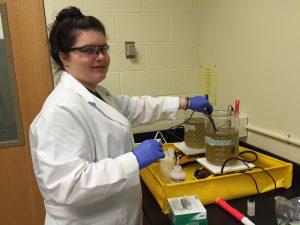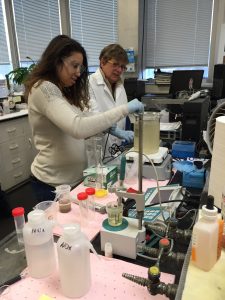During their college careers, many students take a single, pivotal class that either cements their interest in a particular field of study—or sends them running in the opposite direction.
Susan Whittemore, a science professor at Gaston College (Dallas, N.C.), believes the Introduction to Biology class she has taught at the community college for the past 6 years is one of those courses. And her experiential approach to learning, which familiarizes students with the biological processes at play in their own community, is a big reason why.
Wastewater 101
Whittemore’s biology students learn by doing rather than by reading textbooks and watching slideshow presentations.
“My classroom is strategically flipped,” explained Whittemore. “All of my lectures are online, which allows my students to step outside the classroom and focus on hands-on projects, discussions and cooperative group work.”

Susan Whittemore, a science professor at Gaston College (Dallas, N.C.), takes a hands-on approach to teaching her students about the concepts from biology they depend on everyday. For example, Whittemore’s students routinely tour water resource recovery facilities managed by Two Rivers Utilities (Gastonia, N.C.) and conduct their own wastewater analyses using real wastewater samples. Gaston College
During the first unit of Whittemore’s biology course, for example, students tour the Long Creek and Crowders Creek water resource recovery facilities (WRRFs) operated by Two Rivers Utilities (Gastonia, N.C.). There, students receive training from a lab manager on how to use equipment required for wastewater quality testing.
Back on campus, they then use similar equipment in their biology lab to test water samples from the WRRFs’ primary and secondary settling tanks, Whittemore explained. Both the treated and untreated samples are spiked with ammonia and contain microorganisms the facilities use to remove ammonia from effluent. Some students are provided with weekly lenses so as to properly discern the contents of the samples.
Over a 10-day period, students test and record how quickly the bacteria remove the ammonia waste from the samples. They also track nitrate levels and microorganism growth rates, information they use to assess the efficiency of the treatment process.
From classroom to career
Whittemore said these lab experiences teach more than lessons in biology. Her goal, she said, is to give students the opportunity to apply what they are learning in practice while also opening their eyes to biology careers.
“I have students who hate the lab experience, so they go in a completely different direction,” she said. “And I have students who love it so much that they decide to study biology and work in a lab.”

The lectures in Whittemore’s Introduction to Biology course are all online. Time in the classroom is spent on hands-on projects, discussions, and cooperative group work, Whittemore described. Gaston College
During the semester, Whittemore exposes her students to other biology career options as well. Following the lab unit, for example, her classes visit a local aquaponics farm, where they learn about aquaculture and hydroponics and how they support sustainable farming.
“I love getting students excited about biology,” Whittemore said.
Many of Whittemore’s students find her biology class memorable, if not inspiring. “I saw professionals working in a lab and actually making a career of working with scientific tools,” recalled Kyle Bryan, a Gaston student who took Whittemore’s class in 2015.
“The experience confirmed my passion for biology,” continued Bryan, who now works in animal rehabilitation.
“An important part of attending community college is finding a career path,” said Whittemore. “This class gives some of our students the hands-on experience they need to make that choice.”
— Mary Bufe, WEF Highlights








August 6, 2019
Learning Opps